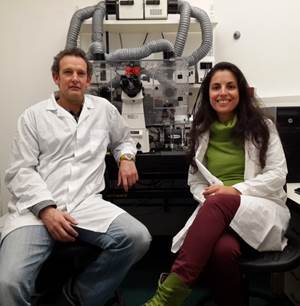
Scientists develop a novel method to suppress malaria parasite’s virulence genes, break the code of its immune evasion

Prof. Ron Dzikowski and PhD student Inbar Amit-Avraham at the Hebrew University of Jerusalem (Photo: Hebrew University of Jerusalem)
Up to one million people – mainly pregnant woman and young children – are killed each year by the Plasmodium falciparum parasite, which causes the most devastating form of human malaria.
Now, researchers at the Hebrew University of Jerusalem have revealed the genetic trickery this deadly parasite deploys to escape attack by the human immune system.
The parasite is known to replicate within the circulating blood of infected individuals and modify the surface of infected red blood cells. Its virulence comes from its impressive ability to hide from the immune system by selectively changing which surface proteins it displays.
This sophisticated game of hide-and-seek, which involves continually alternating the foreign molecules, called antigens, that can trigger an immune response, is called antigenic variation.
Previous research has shown that the antigens the parasite selectively displays are encoded by members of a gene family named var. The parasite tightly regulates the expression of these var genes so that only one is expressed at any given time, while the rest of the family is maintained silent.
Understanding this complex mechanism is essential to understanding how the deadly Plasmodium falciparum parasite evades the immune system. It is also more broadly important to science because the process by which cells can express a single gene while keeping alternative genes silent is one of the unsolved mysteries in the field of eukaryotic gene expression.
In research at the Hebrew University’s Faculty of Medicine, Prof. Ron Dzikowski and his PhD student Inbar Amit-Avraham found that at the precise moment in the cell cycle when a specific var gene is active, corresponding RNA molecules (of a type called long noncoding RNA) are present.
Furthermore, these long noncoding RNA (lncRNAs) molecules incorporate themselves into DNA structures, and determine how the parasite selects a single gene for expression while the rest of the family is kept silent.
In a series of genetic experiments in transgenic parasite lines, the researchers were able to activate silent var genes by expressing their specific lncRNAs molecules, thus demonstrating their functional role in var gene activation.
The research was conducted at the Department of Microbiology and Molecular Genetics at the Institute for Medical Research Israel-Canada, in the Hebrew University’s Faculty of Medicine; and at the Sanford F. Kuvin Center for the Study of Infectious and Tropical Diseases at the Hebrew University-Hadassah Medical School.
In a further development, the researchers collaborated with Dr. Eylon Yavin, at the Institute for Drug Research in the Hebrew University’s School of Pharmacy, to develop a novel way to interfere with these lncRNAs. They further showed that through this interference they could suppress the active var gene, erase the memory that regulates var expression, and induce switching towards expression of other var genes.
The research provides evidence that these lncRNAs molecules play a key role in regulating the genetic mechanisms enabling the deadly parasite to evade human immunity.
According to Prof. Dzikowski, “We believe this breakthrough has exposed the tip of the iceberg in understanding how the deadliest malaria parasite regulates the selective expression of its genes, enabling it to evade the immune system. Understanding the mechanisms by which the parasite evades immunity takes us closer to finding ways to either block this ability, or force the parasite to expose its entire antigenic repertoire and thus allow the human immune system to overcome the disease. Such findings can help pave the way for development of new therapies and vaccines for malaria.”
The study appears in the Proceedings of the National Academy of Sciences (PNAS Early Edition) as Amit-Avraham et al., “Antisense long noncoding RNAs regulate var gene activation in the malaria parasite Plasmodium falciparum” ( www.pnas.org/cgi/doi/10.1073/pnas.1420855112 ).
The research was supported by Israel Academy of Science and Humanities and European Research Council. Inbar Amit-Avraham was supported by the Abisch–Frenkel Foundation.
For information or interviews, contact:
Dov Smith
Hebrew University Foreign Press Liaison
+972-2-5882844 / +972-54-8820860
dovs@savion.huji.ac.il















